Disheveled, Poor and Shabby, The Average Soldier’s Wife
The hobby of reenacting as whole has undergone many changes in the past decade. I would say those changes were made in leaps and bounds towards outstanding impressions done by women in the hobby. We have had some excellent patterns become commercially available based on extant garments for the female living historian. (I’m looking at you Larkin and Smith. Thank you!) The digitization of museum collections and the sharing of those images on social media on sites such as Pinterest has been invaluable. The social networks have transformed our small and often insular community. We now have the ability to connect to one another in ways we never could have imagined. We can share images of our impressions with the world with a small very powerful computer we carry in our pocket. It takes but a second to have your new kit be the all the rage on various pages. Your image may be shared, liked, tweeted and loved. This past spring an event, attended by the 17th, at Short Hills produced some images that were happily shared on my wall. One in particular was of some friends of mine standing around a wash tub doing laundry in their stays and petticoats. It is an image that instantly sparked not only admiration for anyone doing laundry at an event but also a sense of recognition that I have seen so many images of working women wearing just such clothing while doing hard laborious work.
The ability to properly portray Soldier’s Wives as they truly were is really not as difficult as some would have you believe. This is due to the fact that so many images exist from the last quarter of the 18th century. It also doesn’t hurt that we have some excellent purveyors of goods and craftspeople reproducing the material culture of that era, as well. We also mustn’t forget the excellent scholarly works that look into the common person’s clothing such as Dress of the People by John Styles or Wives, Slaves and Servant Girls by Don Hagist. These excellent books delve deeply into the subject and I highly recommend reading both of these publications to get a greater idea of the fabrics worn and the vernacular used in the period. Such wonderful terms such as Stuff, referring to worsted, Cassimere, referring to tropical weight worsted, Harebine, a wool silk blend that is slightly fuzzy on one side yet smooth and taffeta like on the other, Cherry Derry, a cotton silk blend that shows up repeatedly in merchant’s advertisements.
I’ve decided to focus in on the visuals that I referred to earlier. In particular I have chosen a few images rendered by Paul Sandby that very aptly show the look of the common working woman. He focused most of his career painting landscapes, encampments and those living in some of the poorest areas of cities around the UK. He was prolific in his craft and gives us an excellent view of what he saw on a daily basis. The last quarter of the 18th Century was a time almost devoid of social welfare even if it was the “Age of Enlightenment”. These individuals lived in circumstances that would still be recognizable in the third world today. That is what it meant to be the poor working class in a major city in George III’s Britain at the time. He painted them as they were, disheveled, poor, shabby, and most of all, very human. This is the same exact social class of the Private Soldier’s wife which made up over 95% of all Followers of the British Army that we represent. The images I have chosen are from the 1750’s-1790’s as working women’s clothing often were not quite as fashionable or are hard to discern cut due to their ragged condition in the images. The second hand clothing trade kept some pieces of clothing in circulation far beyond the time that a fashionable woman would have worn them.
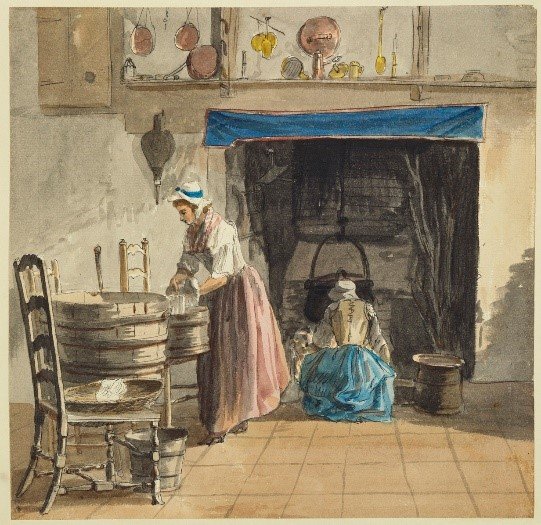
These women appear to be washing indoors. You should notice that both women are in their shift sleeves, stays and petticoats. Take note the standing figure is wearing her handkerchief, as well. The Royal Collection.
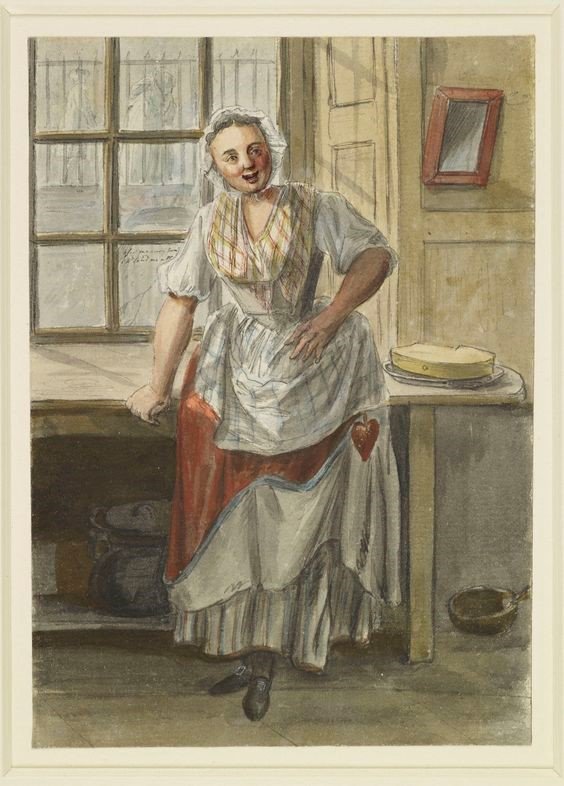
Perhaps my favorite in the series as it gives a highly detailed image of a woman working. Once again, take note of the shift, ferreted petticoats and stays with a handkerchief. Note the details of her windowpane check work apron, as well as the facing on the hem of her petticoat in plain (linen? Wool?) fabric with a striped petticoat underneath. Her pin cushion hangs from her waist as well. The temporary removal of outer garments seems to have been fairly typical when doing manual, filthy or wet work. It is seen repeatedly in images of women doing laundry and other tasks. The Royal Collection.
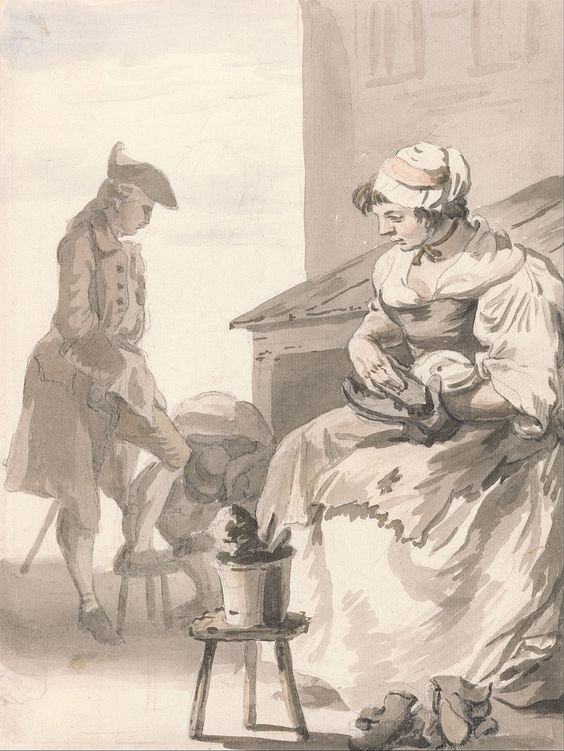
This image once again shows a woman removing her outer garments such as a Bedgown or Gown to keep her outer garments free of filth or water. This seems to have been a common occurrence and for the working class something that was done in a public area. She also has her apron on and her handkerchief is worn covering her shoulders and chest. The London Museum.
The next undated Sandby Etching shows the simple Bedgown and Petticoat worn by a working woman. She is also wearing flat shoes which we see in many images of women of this class. As we have a General Order saying that Widows and Children of the Regiment may draw shoes and Hose form the company stores, flat shoes can be a valuable interpretive tool. You can see the wheelbarrow behind her which should be of much interest to those who do a laundry or Petty Sutler Impression. Note the bare feet on the young boy scratching his head. The British Museum.
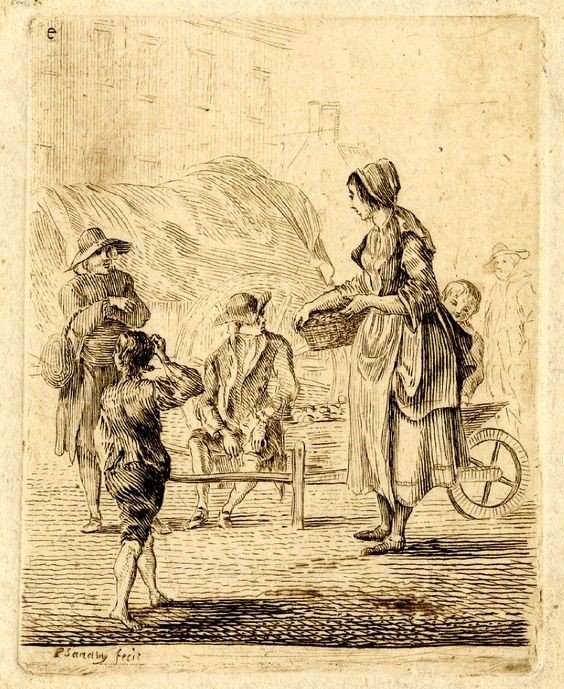
Last Dying Speech and Confession, 1759, from the Twelve Cries of London Series. This
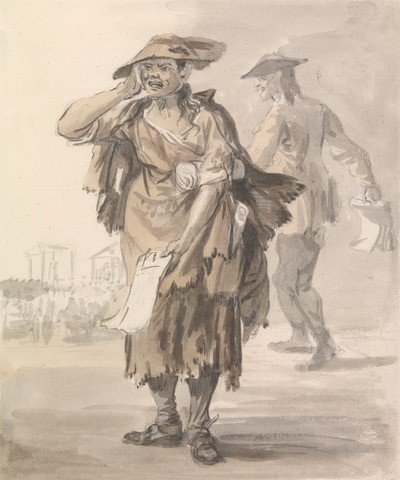
woman has to be the shabbiest of all of the women pictured here. You will notice her Bedgown, Petticoat and Flat Shoes. Please note she is not giving her dying speech she is selling copies of an executed person’s confession at the gallows, which you can see faintly behind her with a crowd around it. Nothing like a day’s entertainment.
Mackerel Seller, 1768. Lastly, this woman with her hand in her pocket, her blue pinner apron to keep the fish oil off her, scarlet cloak and aggressive expression is a personal favorite. She looks very much like many of us do after a weekend in the field hence this is a very achievable look. The surprising lack of gowns in these images is a bit startling but these seem to be the predominant theme in working women’s garments painted by Sandby. National Galleries of Scotland.
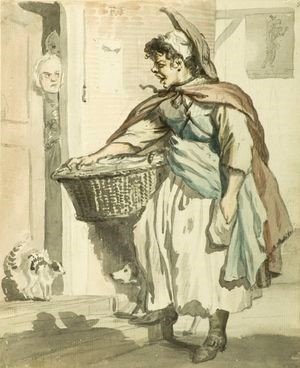
This is but a small sampling of images that are available in digital archives most of which are free or have very little cost in acquiring images. The great hope is that you will investigate these terrific images for yourself, study the details, look at the surroundings and add these small details to your impression. It’s easy to be guided by others impressions but the guidance we should be taking is from period images. I chose these images because they illustrate what a soldier’s wife may have looked like after a while on active campaign. We know they are described as a rather ramshackle lot by the locals when the Convention Army passed through New England. Perhaps we’ll see some more working class clothing at events soon.
* Please note second in series is how Sandby numbered this image. It is the first shown in this post.
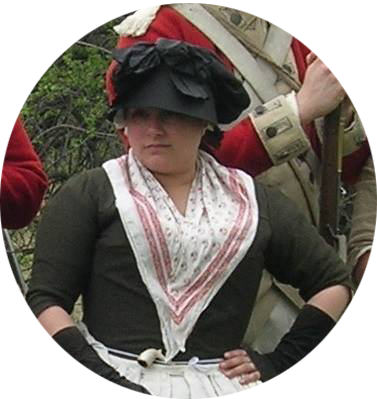 JENNA SCHNITZERis a a member of the 62d Regiment of Foot. She has been a Historic Interpreter since 1993. When she isn't researching or doing experimental archaeology she is either antiquing or restoring the 18th century home she owns with her Husband Eric and their two very bossy cats Georgie and Charlotte.
JENNA SCHNITZERis a a member of the 62d Regiment of Foot. She has been a Historic Interpreter since 1993. When she isn't researching or doing experimental archaeology she is either antiquing or restoring the 18th century home she owns with her Husband Eric and their two very bossy cats Georgie and Charlotte.

